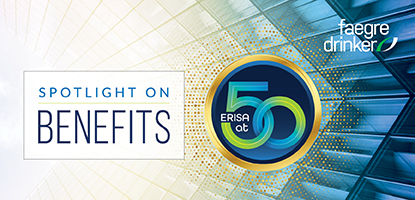As most of the nation continues under lockdown due to the COVID-19 pandemic, we have received inquiries about ways employers can provide additional benefits to employees during this unprecedented time.
On March 13, 2020, the COVID-19 pandemic was declared a “disaster” by President Trump under the Stafford Act. While this designation may not be enough to permit hardship distributions from all retirement plans, the “disaster” declaration under the Stafford Act does trigger availability of Code Section 139 – a little known and seldom used provision in the tax code added after the 9/11 terrorist attacks – that will permit an employer to provide tax-free “qualified disaster relief payments” to employees, if they meet certain requirements. First highlighted by our tax colleagues in a blog post on April 6, 2020, here we expand on how Code Section 139 works for our employer clients considering such a program.
Qualified Disaster Relief Payments
To receive favorable tax treatment, the payment must be a “qualified disaster relief payment.” This includes payments for “reasonable and necessary personal, family, living, or funeral expenses incurred as a result of a qualified disaster,” so long as such expenses are not otherwise compensated for by insurance or other means.
Other than Revenue Ruling 2003-12, which applies Code Section 139 to reimbursements by an employer for an employee’s medical, temporary housing and transportation expenses related to a flood, there are no other regulations or guidance to indicate how Code Section 139 should be applied. However, the committee report issued by the Joint Committee on Taxation (JCX-93-01) when Code Section 139 was added to the Code indicates Congress’s intent that qualifying expenses might include expenses for:
-
- Rent, water, utilities and other expenses of maintaining a household
- Travel away from home (e., transportation, meals, lodging)
- Medical expenses that would be deductible under Code Section 213
- Child care expenses.[1]
Tax Treatment of Qualified Disaster Relief Payments
Qualified disaster relief payments are excluded from gross income and are not subject to federal income tax, FICA or FUTA withholding; further, the payments are deductible by the employer. Thus, they do not have to be reported as income by the employee on an employee’s Form W-2 or on a Form 1099. Employers should be aware, however, that Code Section 139 only addresses the tax treatment of these benefits under federal law; applicable state laws will need to be examined to determine if such amounts are subject to state income tax withholding.
Substantiation Requirements
Code Section 139 does not impose any requirements for recordkeeping or substantiation that the payments were for qualifying expenses. The legislative history indicates that Congress anticipated “that individuals will not be required to account for actual expenses in order to qualify for the exclusion, provided that the amount of the payments can be reasonably expected to be commensurate with the expense incurred.” In its only guidance addressing Code Section 139 benefits, the IRS confirmed this intent, noting that it will not require any substantiation of payments and expenses incurred by individual recipients. It may be prudent, however, for employers to maintain adequate records of such payments to substantiate any deduction taken.
Faegre Drinker Observations
Employers considering the implementation of a Code Section 139 program should take into account the following:
- State income and state unemployment taxes may apply to payments made under this type of program.
- Most of the typical legal rules governing employee benefit arrangements, such as ERISA, do not apply.
- There are no nondiscrimination rules and no dollar limits on the amount reimbursed to an employee (so long as it is reasonable and necessary to meet the expense incurred due to the disaster).
- Although no formal plan document is required, employers may consider developing a policy document that explains various aspects of the program such as:
- the eligible employee group
- the types of expenses the employer will reimburse
- how the benefits will be provided (g., whether an application will be required and whether the employer will pay the expense directly or require employees to submit receipts for reimbursement)
- any employer-imposed expense limit per employee
- start and end date of the program
- Any amounts paid to or on behalf of an employee must not be reimbursable by insurance or some other form of reimbursement and should not include luxury, decorative or non-essential services or items.
We would expect that Code Section 139 payments would be excluded from the definition of compensation for purposes of most retirement plans (e.g., 401(k) plans) but would recommend that employers confirm that before making the payments.
We also should note that some flexible spending account (FSA) administrators are marketing “reimbursement account” products to employers that allow for reimbursements of expenses, some of which may qualify for tax-free treatment under Code Section 139. Employers wanting to set up a program that provides reimbursements may want to see if their FSA administrator can assist. However, employers also should consider whether the reimbursement program is limited to “qualified disaster relief payments” or may include taxable benefits.
Conclusion
The COVID-19 pandemic presents unique challenges for employers, especially for employers providing essential services. The designation of the pandemic as a “disaster” has brought Code Section 139 out of the shadows and into the sunlight as a way that employers can offer tax-free benefits to cover increased disaster-related costs of employees.
[1] The Joint Committee on Taxation report references Code Section 262 to define “personal, family or living expenses.”
The material contained in this communication is informational, general in nature and does not constitute legal advice. The material contained in this communication should not be relied upon or used without consulting a lawyer to consider your specific circumstances. This communication was published on the date specified and may not include any changes in the topics, laws, rules or regulations covered. Receipt of this communication does not establish an attorney-client relationship. In some jurisdictions, this communication may be considered attorney advertising.

